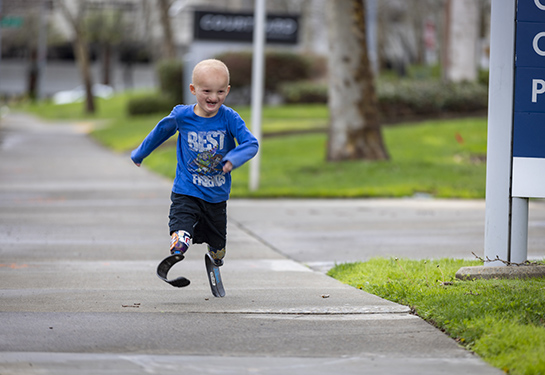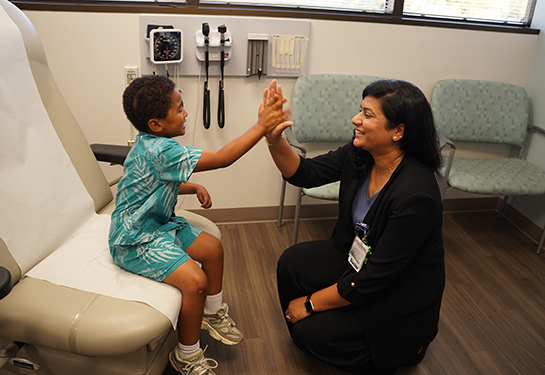Search for top spinal surgeon led Alaskan family to UC Davis
“I want to climb mountains again,” said Tiffany Balts, her voice steady with hope, as she lay in her bed at UC Davis Medical Center last month.
For most people, that might sound like a dream. For the 22-year-old native-born Alaskan, it’s a return to the life she once lived — hunting caribou in the Arctic Circle and trekking through the snow-covered tundra.
Tiffany has a rare congenital spinal condition that caused pain that most people couldn’t imagine. Her journey from Alaska to UC Davis Health in Sacramento is a story of resilience and faith in the life-changing care and expertise of neurosurgeon Kee Kim.
A family’s shared struggle

Tiffany was born with a missing part of a vertebra. “She was a 10-pound baby, and from birth, she refused to sleep on her back,” her mom Betsy Balts recalled. “She would rub her back constantly. I knew something was wrong.”
Betsy, Tiffany and several family members were born with a hereditary Pars defect, also known as spondylolysis. This condition causes a fracture in the pars interarticularis, a small bone in the lower back. It can cause pain in the lower back and legs.
Despite the pain Pars caused, Tiffany was determined to lead an active life. She earned her black belt in Taekwondo at age 12 and went on days-long hunting expeditions in Alaska. She tried to mask her discomfort.
“She would cry when no one was looking,” Betsy said. “Then she’d tell her dad, ‘Don’t tell the other hunters I cried.’”
Dad’s terrible headaches

Meanwhile, Tiffany’s father, Mark Balts, struggled with his own hidden injury. The former Marine broke his neck during a training accident in 1996. He didn’t realize the extent of the injury until 15 years later, when he slipped on ice and hurt his neck again. An X-ray and an MRI of his neck showed that the old injury was pinching his nerves.
“I thought I pulled a muscle,” he said. “You always hear that if you break your neck, you’re paralyzed. So, I didn’t say anything.”
By 2011, Mark was suffering from terrible migraines nearly every single day. “It felt like my head was being hit with a sledgehammer, with electrical shocks running through my body,” he said. “If I didn’t have a family to care for, I would have found a way to die. That’s how bad it was.”
The search for a top surgeon
Betsy, the family’s caregiver and advocate, began searching for help. “I looked up the top 20 spinal neurosurgeons in the U.S.,” she said. “I made a file for each one, checked malpractice records, patient reviews and how they treated conditions like Mark’s.”
Her search led her to UC Davis Health neurosurgeon Kee Kim. “He was one of the top three spinal neurosurgeons and the most innovative,” she said. The Balts reached out to Kim.
“Mark had disabling headaches with neck and left arm pain. Most physicians don’t connect chronic headache with neck problems,” said Kim, professor of neurological surgery and the chief of spinal neurosurgery. He is also the co-director of UC Davis Spine Center. “Mark needed an anterior C5-6 discectomy to take the pressure off the pinched spinal cord and nerves.”

The most common procedure at that time, called anterior cervical discectomy and fusion, involved removing the damaged disc and fusing the vertebrae to stabilize the spine. But Kim did something more innovative.
“Instead of fusing the spine, Dr. Kim used a device he refined that allows motion. It gave Mark his life back,” Betsy said.
Mark had his operation in September 2014.
The procedure was a lifesaver. “The day after surgery, I had feeling back in my arm for the first time in years. My migraines dropped from 27 a month to three in the first year. It was like I was 20 years younger,” Mark said with a smile.
Tiffany’s turn
Fast forward a decade or so. Mark and Betsy watched their daughter’s condition get worse. Tiffany cracked a vertebra riding an all-terrain vehicle during a hunt. She had a compression of nerves at the end of her spine due to a slipped disk and the malformed vertebra. She could no longer feel the bottom of her feet, drive or continue learning to fly.

“I was living at a pain level of 8 or 9 every day,” Tiffany said. “I was basically stuck in bed.”
In January 2025, she twisted her lower back while opening a restaurant door, paralyzing three toes.
“Tiffany stubbed her toe one day,” Betsy said. “She didn’t even realize she was bleeding from her foot. She had cut her toe and couldn’t feel it. That’s when we knew we had to act, so we reached out to Dr. Kim.”
For the Balts family, the choice to travel from Alaska to California was clear. “The doctors we saw in Alaska didn’t understand our condition,” Betsy said. “One pediatrician told me he’d never heard of ‘Pars defect.’ They’d feel Tiffany’s spine and say, ‘I don’t feel anything.’”
On Oct. 29, 2025, Kim and general surgeon Ho Phan performed a spine surgery on Tiffany.
“Tiffany had an unstable or loose spine. Her progressive condition caused excruciating leg and back pain and right toe weakness,” Kim explained. “We did a robotic-assisted spine fusion (arthrodesis) for her L5-S1. I am very thankful that she is doing well.”

Looking Ahead
Tiffany is focused on recovery. A week after her surgery, she was able to walk without a cane or walker for the first time in three years. She regained sensation in her feet and movement of her toes.

“Now I can feel my feet again. I want to learn to drive again. I want to climb mountains. I want to hike again. I want to be active. I want to live without pain,” she said.
Mark also is pain-free, and back at work. “Don’t ever quit,” he said. “God’s got a plan. Just because you don’t know what’s down the road doesn’t mean there isn’t something good waiting for you”.
Throughout it all, Betsy has been the family’s rock. “I tracked every migraine Mark had —what triggered it, what helped, what didn’t,” she said. “Dr. Kim even used my notes in his presentations.”
She now runs an assisted living home, despite her own spinal pain. “Dr. Kim keeps asking me, ‘When’s your turn?’” she said with a smile. “I’m 60 next year. I know I’ll need surgery too.”
And when she does, neurosurgeon Kee Kim will be ready for her.




